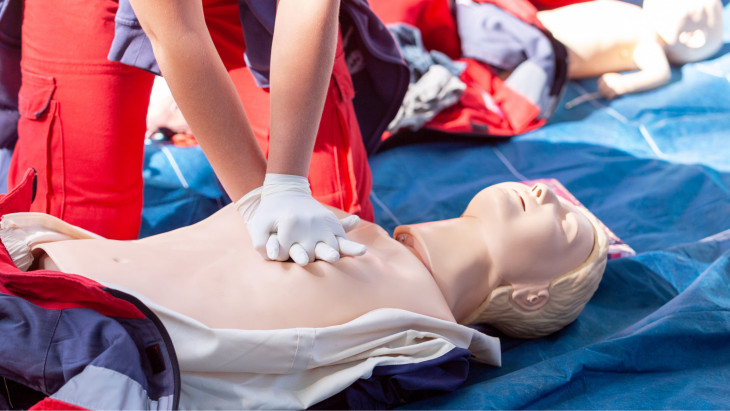By The Acclaim Team on 19th August 2025 in News
Starting in 2026, the UK Driver and Vehicle Standards Agency (DVSA) will introduce enhanced first aid content into the car and motorcycle theory tests. For the first time ever, questions on using an Automated External Defibrillator (AED) will be added, alongside expanded CPR (cardiopulmonary resuscitation) questions. No additional test time or cost will be required; the update simply modernises existing first aid content.
Why this matters more than ever
-
Drivers are often first on the scene
With over 40,000 cardiac arrests occurring outside a hospital in the UK annually, and a survival rate of under 10%, you (as a driver) could be the first person there. Proper CPR and AED use can boost survival to as high as 70%, especially when administered within the first few minutes.
-
Your theory test just went real world
The DVSA Chief Driving Examiner explains, “Part of being a safe and responsible driver is knowing what to do in an emergency - how to step in and make a real, life‑saving difference.”
-
You’re not starting from scratch
Most updated learning materials (DVSA guides and official apps) have already been revised to include these skills.
What learners need to know
Q1: When do these new questions start appearing?
A: The updates will be included in theory tests starting in early 2026. DVSA encourages early preparation using the enhanced resources now available.
Q2: Do I need to take special training for this?
Yes, but it’s simple and accessible. Basic CPR and AED guidance is available via Resuscitation Council UK and “Save a Life” programmes across the UK. Practicing these alongside your normal theory revision will prepare you well.
Q3: What are the example questions like?
Example CPR questions may include:
“What’s the correct depth of chest compression during CPR?”
“Who is legally allowed to use a public defibrillator (AED) in the UK?”
“At what rate should chest compressions be performed during CPR?”
“What’s the first thing you should do when you see someone collapsed and unresponsive?”
“After switching on a defibrillator (AED), what should you do next?”
“What is the purpose of using an AED in a cardiac arrest situation?”
Q4: Does it make passing harder?
Not really. You’ll still face 50 multiple-choice questions (must answer 43 correctly to pass) and the hazard perception test as usual. It’s just that first aid scenarios are now more realistic.
Q5: Why is this change happening?
DVSA’s goal is to equip drivers with life-saving skills. New drivers can now play a vital role in emergencies while waiting for medical help, this move aligns with campaigns across the UK to increase bystander CPR and AED use.
Check out Acclaim’s other FAQs for more answers!
What this means for your theory test preparation
With new CPR and defibrillator (AED) questions being introduced into the theory test, it’s important that learners adapt their revision approach to include practical, life-saving knowledge, not just traffic signs and road rules. Here's how to prepare effectively.
Start with the most up-to-date learning materials
Make sure you’re studying with the latest DVSA-approved revision guides and apps, as these now include the updated CPR and AED content. This could be as simple as updating the app you’re currently using! This ensures you're learning the exact type of questions you’ll face in the 2026 theory test, including lifesaving techniques and emergency response knowledge.
Practice with real-world scenarios, not just flashcards
Move beyond rote learning. Try to visualise emergency situations and how you would respond as a driver. Look out for local Red Cross or St John Ambulance workshops, which offer hands on training in CPR and AED use, a great way to solidify your knowledge in real-life settings.
Revise on the go with free mobile tools
The British Heart Foundation’s “RevivR” tool is a great example of bitesize learning done right. It offers free online CPR training that takes just 15 minutes and can be done from your phone at any time, ideal for squeezing in revision between lessons or school.
Take full-length mock tests under exam conditions
Once you’ve revised the core material, test yourself under pressure. Take full, timed mock theory tests to get used to the pacing and format. You can use the free official GOV.UK practice test or other trusted theory apps to simulate the real exam experience.
Learn the facts, don’t just skim through them
Certain details in CPR and first aid can be life-saving, so commit them to memory. For example: the correct compression depth (5–6 cm), the rate of compressions (100–120 per minute), and how to operate an AED. These facts may come up in the test, but more importantly, they could one day help you save someone’s life.
Reinforce your knowledge with physical practice
Try simulating chest compressions at home using a pillow or cushion. This helps you understand how much pressure is needed and builds muscle memory, which could be valuable in a high-stress emergency situation. It also makes the theory feel more “real” and easier to remember.
Revise Smarter with the #1 Theory Test App
Ready to ace your theory test, including the new CPR and first aid updates?
Download the leading Theory Test Revision App, just £7.50 for three months of full access, trusted by over 12 million UK learners, and access:
-
Up-to-date DVSA-approved questions
-
Mock tests and hazard perception practice
-
First aid & CPR content aligned to 2025 changes
-
Progress tracking and smart revision tools




